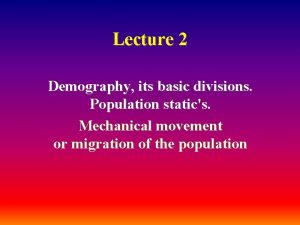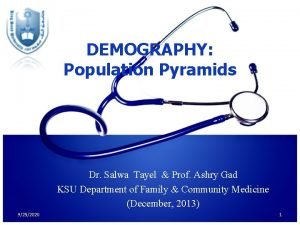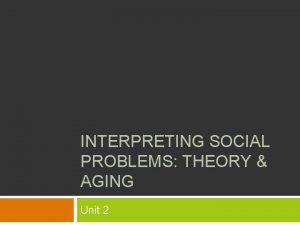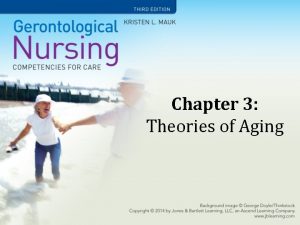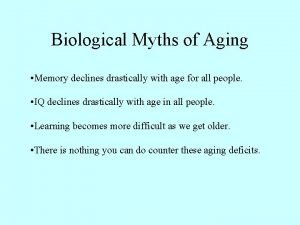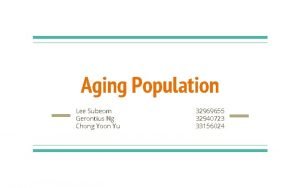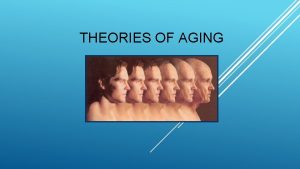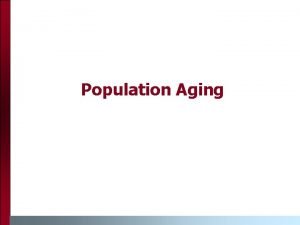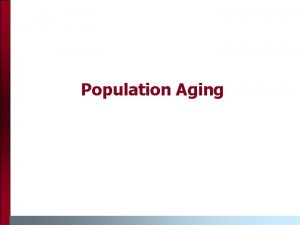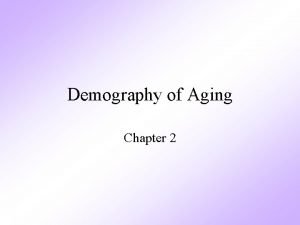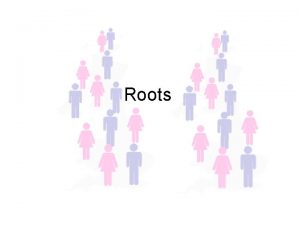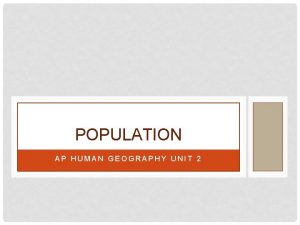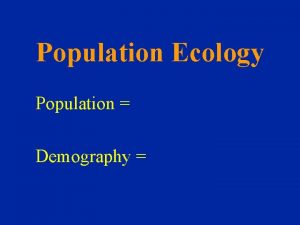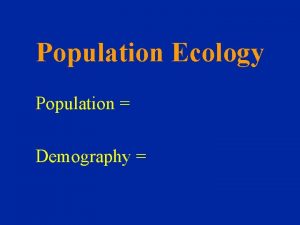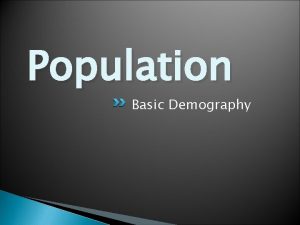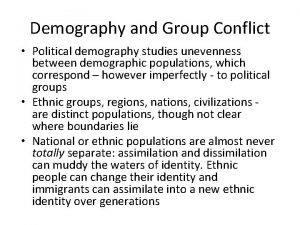DEMOGRAPHY OF AGING CHAPTER OUTLINE Sources of population




























- Slides: 28

DEMOGRAPHY OF AGING

CHAPTER OUTLINE • Sources of population data • Individual aging processes • Population aging • Population trends in the United States

INTRODUCTION Cohort size is determined by basic population processes—fertility (the number of births), mortality (the number of deaths), and migration (the arrival of new members from other countries). These processes are the subject matter of demography; in combination they determine a population’s age structure, or the proportion of people in various age cohorts. Population aging is a gradual increase in the proportion of older people to younger people. VIDEO – Some opening thoughts about world wide aging…

SOURCES OF POPULATION DATA In the United States, the Bureau of the Census is the central clearinghouse for all national population data. The Census Bureau makes national counts of the population every ten years and obtains information from each household on births, deaths, country of origin of the residents, health, living arrangements, occupation, and income. Policy decisions are made on the basis of census numbers, such errors can affect which groups receive funding and how much they receive. These problems are magnified when the United Nations confronts the task of compiling world population data. Age is one of the most difficult measures of precise data. In an attempt to deal with such problems, the United Nations has developed a code for indicating its confidence in international demographic data. The code does not eliminate errors, thus the comparisons of international population trends must be made with caution. International Data Base (census. gov) Web link Overview of Population Demographics (2016). (This animation puts the entire US population into perspective) ( World demographics)

INDIVIDUAL AGING PROCESS – LIFE SPAN There are two ways to measure individual aging: 1) Life Span, and, 2) Life Expectancy. Gender differences in the life expectancy affect the sex ration One measure of individual age is the life span, defined as the greatest number of years any member of a species has been known to survive. The human life span appears to be about 120 years, although there a few recorded cases of people living to be much older. Humans are the longest-lived animals. In developed countries, over the last century, human life expectancy has moved closer to the human life span.

INDIVIDUAL AGING PROCESS – LIFE EXPECTANCY AND SEX RATIO Life expectancy is the average number of years people in a given population can expect to live or, more precisely, the mean age at death. Generally, life expectancy worldwide is higher for females than for males. Scientists cannot fully explain the gender difference in life expectancy, which arises from a complex interaction of biological, social, and behavioral factors. The sex ratio is defined as the number of males to every 100 females. For every 106 male babies that are born, there are only 100 females; however, after birth, death rates are persistently higher among males, beginning in infancy and continuing into old age. As a result, the sex ratio declines progressively over the life course resulting in a large deficit in men in very old age. ▪ In most nations, elderly women greatly outnumber elderly men. ▪

POPULATION AGING A population’s age (population age increases with the increase in proportion of the elderly) structure can change through three fundamental demographic processes: fertility, mortality, and migration. The fertility rate is a measure of the incidence of births or the inflow of new lives into a population. Generally, a declining birth rate is the main factor that can result in population aging. Mortality (death) rates, the second process that influences age structure, reflect the incidence of death in a population. Migration, the third process, is the movement of people across borders. Migration typically exerts the least amount of influences on population aging. One way to display the age structure of a population is to construct a population pyramid, a bar chart that reflects the distribution of a population by age and sex. See Figure 4. 1, next slide.

POPULATION AGING When a population is young it exhibits a triangle with a wide base and narrow apex. Fertility is high and death impacts the population at younger ages A population becomes middle aged when fertility declines along with infant and child mortality, fewer children are born, and more survive A population becomes old when mortality is reduced at all ages, but especially among the elderly.

POPULATION AGING – DEMOGRAPHIC TRANSITION In all developed nations, the three-stage shift from high mortality and fertility rates to low mortality and fertility rates occurs through a socioeconomic process called the demographic transition. As countries industrialize, accompanying changes in fertility and mortality produce changes in population structure. At the end of this process, a country’s population is both older and larger. In the first stage of the demographic transition, the economy is agricultural, women marry young and have many children, and infants commonly die from acute and infectious diseases. Because birth rates and death rates are both high, few people reach adulthood, and even fewer survive to old age The second stage of the demographic transition is characterized by declining death rates and population growth. More children survive into adulthood. When these children reach childbearing age, significant population growth occurs. Through improved sanitary measures and health care, life expectancy increases, mortality among the old begins to drop, and the proportion of older people in the population grows In the third stage, the population as a whole begins to age, and more deaths are caused by chronic ailments than by acute illness. When birth and death rates are both low, the demographic transition is complete. At that point a nation can be characterized as “old, ” demographically speaking. ( see Figure 4. 2, next slide )

POPULATION AGING STAGES OF DEMOGRAPHIC TRANSITION There also four and five stage demographic transition models that basically follow the three stage models, with the exception that the five stage model accounts for a decrease in population.

POPULATION AGING - INTERNATIONAL VARIATIONS IN POPULATION AGING The world’s population is aging rapidly due to the factors of declining fertility, rising longevity and the aging of large cohorts, like the baby boomers in the U. S. Japan is the oldest nation with 23 percent of the population 65 and older, while in Kuwait and Bahrain only two percent of the population is that old. The oldest nations are in Western Europe and North America, while the youngest countries are in Latin America and Africa The reason for this disparity is that most of Africa and parts of Asia and Latin America are still in the first stage of the demographic transition with high levels of fertility, young population profiles, and low life expectancy European countries had a low fertility and mortality rates for decades and now have high proportions of elderly Over the next 30 years disparities in life expectancy among many countries of the world are expected to decrease, resulting in global increase in life expectancy See Table 4 -1 (next slide)

POPULATION AGING

POPULATION AGING - DEPENDENCY RATIOS Another way to measure population aging is through dependency ratios, which indicate the burden of supporting an aging population. The ratio of old people to adults, called the elderly dependency ratio, is calculated as the number of persons aged 65 and older per 100 persons of working age (18 to 64 years old). It provides a rough estimate of the proportion of the “working “ population vs. retirees The child dependency ratio indicates the number of persons under age 18 relative to those of working age. This population is also dependent on the “working” population. The combined ratio of children and older people to “workers” is called the total dependency ratio. Dependency ratios are useful in estimating caregiving burden (determine the supply of caregivers relative to those who need care)

POPULATION TRENDS IN THE UNITED STATES - THE CHANGING AGE STRUCTURE n = millions Throughout the twentieth century, the United States was aging, and the rate of change will accelerate during the twenty-first century. Equally important, the population of people 85 and older is expected to triple by 2040 (21% of total population).

DISCUSSION Aging Culture What types of societal strains could a significant increase in the older population (>65 yrs. ) promote? Economic Political Social What types of societal benefits could a significant increase in the older population (>65 yrs. ) promote? Economic Political Social

POPULATION TRENDS IN THE UNITED STATES FERTILITY The baby boom was created by an upsurge in fertility during the post– World War II era. Fertility began to climb in 1946, peaking in 1958 at a whopping average of 3. 17 children per woman. But then, between 1971 and 1980, the fertility rate dropped dramatically, reaching an all-time low of 1. 7 children per woman. Several factors contributed to this reduced fertility. One was the birth control pill, which became available in the early 1960 s. Another was an increase in educational opportunities for women. Finally, female labor force participation expanded rapidly in the 1960 s. As women became more highly educated, they sought work outside the home in increasing numbers.

POPULATION TRENDS IN THE UNITED STATES FERTILITY Although baby boom children had fewer children than their parents generation, the number of babies born to their generation increased because of the large number of baby boomers.

POPULATION TRENDS IN THE UNITED STATES FERTILITY The effect of fertility trends on the age structure in the United states is depicted in Figure 4 -5. The 1970 graph (top) show low birth rates during the depression (ages 30 -40), and baby boom bulge just beginning to appear at the bottom of the graph The 2010 graph (bottom) depicts the aging baby boom population.

POPULATION TRENDS IN THE UNITED STATESMORTALITY The greatest declines in mortality occurred during two periods, the 1940 s and the 1970 s. In the 1940 s medical advances led to major gains against infant and child mortality and maternal mortality. Then, beginning in the late 1960 s, the death rate from heart disease began to fall, largely because of better prevention and treatment: Fewer people smoked, and new medications helped to control hypertension (high blood pressure). Heart disease remains the leading cause of death among people over 65. Cancer deaths have increased among the elderly Among the very old, the advantages associated with being white disappear. An intriguing phenomenon, one not fully understood, is what is called race crossover. After age 85, the mortality rate for African Americans falls below that of whites. In advanced old age, older black adults have lower mortality risk than whites SES affects health in several ways. People with higher incomes are more likely than the poor to have health insurance and good health care. They are also more likely to live in less polluted areas and to have better access to public services. SES also affects lifestyle. Middle-class people are more likely than the poor to exercise regularly, control their weight, and eat breakfast, and they are less likely to smoke or drink excessively

POPULATION TRENDS IN THE UNITED STATES MIGRATION The biggest wave of immigrants arrived in the late nineteenth and early twentieth centuries, when thousands of Italians and East Europeans crossed the Atlantic Ocean. The three main regions of origin of the foreign-born population are Latin America, Asia, and Europe. (See Figure 4 -7, next slide) Because of higher immigration and birth rates, the Hispanic, African American, and Asian populations are increasing more rapidly than the white population of the United States. The elderly population of the future will be considerably more racially and ethnically diverse than the elderly population of today.

POPULATION TRENDS IN THE UNITED STATES MIGRATION

POPULATION TRENDS IN THE UNITED STATES MIGRATION By 2050 the non-Hispanic white population is projected to decline from 87 % of people 65 and older to 78%. Thus, the elderly population of the future will be more racially and ethnically diverse than present day.

DISCUSSION Demographers recognize the contributions immigrants make to a developed nation’s population structure. Yet many Americans feel threatened by immigrants. What can be done to improve the immigrant’s public image?

POPULATION TRENDS IN THE UNITED STATES DEPENDENCY RATIO The fact that the large cohort of the baby boom was followed by a small cohort of the baby bust means that the elderly dependency ratio will rise from 20 per 100 in 1990 to 37 per 100 by 2030. In the year 2000 there were more than five workers for each person over 65; by 2030, there will be fewer than three. In 2030 the total dependency ratio will be no higher than it was in 1970, but the composition of dependents will be different(see Table 4 -2). The shift is from the child to old-age dependency ratio.

POPULATION TRENDS IN THE UNITED STATES - LIFE EXPECTANCY Over the course of the twentieth century, Americans have experienced large gains in life expectancy. Between 1900 and 2010, overall life expectancy at birth increased by over 30 years, from 47. 3 to 78. 7 years. In 1900 infant mortality rates were high, and if a person survived to age 20, they might easily expect to live to age 65. Because of the high infant mortality rate, the average life expectancy was low at 47. 3 yrs. Thus it is important to determine life expectancy at birth and life expectancy at 65, and both have improved over the last century. Despite these gains, significant racial and ethnic disparities in life expectancy remain. (see also Table 4 -3, p. 84, text) There has also been a growing wealth gap in life expectancy. The highest earning men can expect to life nearly eight years longer than low income men. A similar pattern can be seen for women

POPULATION TRENDS IN THE UNITED STATES - THE U. S. SEX RATIO During the twentieth century, there was a significant decline in the sex ratio among people 85 and older, from around 80 until the mid-1940 s to only 58 by 2010 This lopsided ratio was a result of the greater increase in female life expectancy compared with male life expectancy. The high proportion of women among the oldest–old has important social consequences. It means that the majority of older women are single—and single women have the highest poverty rates among the aged. It also means that while most men will have a resident caretaker when they become ill or disabled, many women will be institutionalized. One of the most pressing issues is health care and who will pay for it

DISCUSSION VIDEO Old and Poor: America's Forgotten Poverty rates among older women, especially minority women, are very high. What kind of measures might help reduce poverty among the elderly?

ADDITIONAL INTERNET RESOURCES Administration on Aging (http: //www. aoa. gov/) United States Census Bureau (https: //www. census. gov/newsroom/press-releases/2017/incomepovery. html ) Income, Poverty and Health Insurance Coverage in the United States: 2016 The Social Security Administration (http: //www. ssa. gov) It includes the income data and other special and working reports on the elderly population in the United States. Fact-Checking the Future of Aging in America (2012) This is a National Public Radio broadcast that discusses some of the challenges facing the baby boom generation as they prepare for retirement. This resource is made available online at www. npr. org/2012/08/16/158936470/fact-checking-the-future-of-aging-in-america.
 Sources of demography ppt
Sources of demography ppt Demographic data definition
Demographic data definition Static demography
Static demography Cso business demography
Cso business demography Elements of demography
Elements of demography Hotelling model ap human geography
Hotelling model ap human geography Components of demography
Components of demography Demography antonym
Demography antonym Chapter 4 population ecology answer key
Chapter 4 population ecology answer key Chapter 4 population ecology section 1 population dynamics
Chapter 4 population ecology section 1 population dynamics Print sources of information
Print sources of information Water management importance
Water management importance Sources of population data
Sources of population data Population ecology section 1 population dynamics answer key
Population ecology section 1 population dynamics answer key Population ecology section 1 population dynamics
Population ecology section 1 population dynamics 10:5 meeting the needs of the elderly
10:5 meeting the needs of the elderly Sandwich in a sentence
Sandwich in a sentence Human needs theory of aging
Human needs theory of aging Philosophy for old age
Philosophy for old age Different kind
Different kind Problems with conflict theory
Problems with conflict theory Aging algorithm page replacement
Aging algorithm page replacement Non stochastic theory of aging
Non stochastic theory of aging Conclusion of aging
Conclusion of aging Dr berg how to look younger
Dr berg how to look younger Alaska commission on aging
Alaska commission on aging Subeom
Subeom Aging aircraft solutions
Aging aircraft solutions Micro theories of aging
Micro theories of aging


